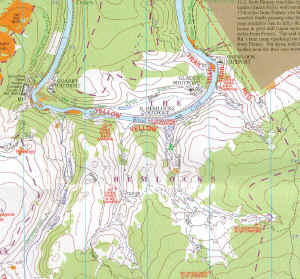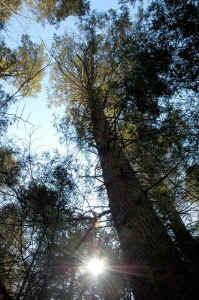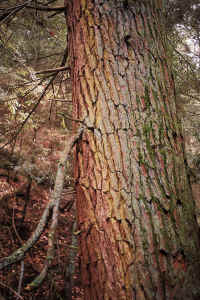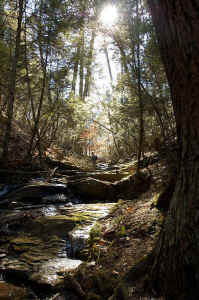Broad Creek Memorial Scout Reservation, Maryland
|
ENTS,
This past Saturday, Joe and I visited a stand of hemlocks
growing in the Broad Creek Memorial Scout Reservation in Harford
County, Maryland. This location is north of Baltimore and west
of the Susquehanna River. The hemlocks on the property grow
along the south side of a large bend in Broad Creek and in a
series of ravines running south to north that feed into the
creek. Two of the ravines, those of Glades Branch and Hemlocks
Branch have the biggest and oldest hemlocks. According to the
Scout Reservation, the oldest hemlocks have been growing since
the 1730's. There were a significant number of large trees, but
some large ones had blown down within the past two years. There
were many seedlings sprouting and most importantly no sign of
wooly adelgid. The groves are relatively small, and appear to be
monitored, but I don't know if they receive any treatment.
Darian Copiz

This portion of the map of Broad Creek Memorial Scout Reservation shows the ravines in which the old growth hemlocks grow. The green tree in Hemlocks Ravine marks the spot where what is claimed to be the second largest hemlock in Maryland grows.
Hemlocks are not very common in
Maryland's piedmont, although in some locations they do even
grow in the coastal plain. As far as I know, this is the only
old growth stand of hemlocks in Maryland growing outside of the
Allegheny Plateau. From what we saw of the rest of the Scout
Reservation, there were few other significantly large trees
except for a few tuliptrees along Broad Creek. This area north
of Baltimore receives the highest amount of rainfall in the
state's piedmont. The area also has a few pockets of species
that generally occur further north, including yellow birch.
We measured four of the largest trees including what was claimed
as Maryland's second largest hemlock. The tuliptree along Broad
Creek is also included.
Tsuga canadensis 10' 7" x 141.2' directly
on west bank of Glades Branch
Tsuga canadensis 9' 1" x 141.3' east
slope of Glades Branch
Tsuga canadensis na x 139.6' west
slope of Glades Branch
Tsuga canadensis 12' 1" x 134.6' directly
on east bank of Hemlocks Branch, second largest in MD
Liriodendron tulipifera 8' 11"
x 133.0' south bank of Broad Creek
I found the tree located directly on the west bank of Glades
branch to be the most impressive and exciting. It leans
substantially over the creek. Both this one and the 12' 1"
cbh trees were growing directly at the edge of their respective
creeks.
|
 |
This beautiful hemlock
leans over Glades Branch. It's base is located directly adjacent
to the creek. The picture of the turnk was taken in February,
2003. When taking the picture, Darian foolishly forgot his water
bottle resting near the tree. When photographing the tree again
in February 2005, he found the same water bottle resting exactly
as he had left it. Although he was thirsty, he didn't drink the
two year old water inside. |
 |
 |
This view looks south up Glades Branch from the large leaning hemlock which is visible at the right edge of the picture. |
 |
With all the other equipment it's easy to overlook simple pen and paper, so Darian enters the dimensions of this
141.3' hemlock into his cell phone. |
 |
Joe looking up from the base of what is claimed to be the second largest hemlock in Maryland. A nice patch of liverwort is growing to his lower left. |
 |
This is claimed as the second largest hemlock in Maryland.
|
| RE:
Maryland hemlocks |
Robert
Leverett |
| Feb
24, 2005 06:23 PST |
Darian:
Outstanding job. Tsuga canadensis continues to
impress, if not
astound me. In my many tree books, I often find authors
describing the
species as a medium-sized tree and given dimensions for it that
fall far
short of the species that I know. The current tall tree champion
hemlock
of New England stands 138 feet tall. The largest ones in girth
are on
the order of 14 to 15 feet. Dale Luthringer's Pennsylvania
hemlocks get
to almost 146 feet in height and 16 feet around. Will Blozan's
hemlocks
go off the charts. Heights to just under 170 feet have been
recorded
many times now and Will has measured 16 to 18-foot circumference
in the
Smokies.
We have examples of the species at the
boundaries of its range, such
as the one's you measured and the one's Jess has measured, and
they are
spectacular trees.
Bob
|
|